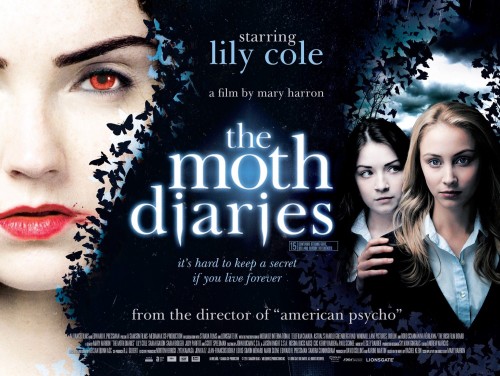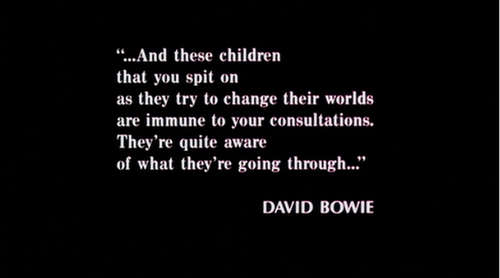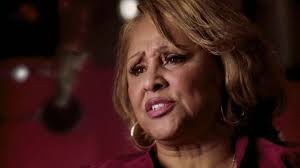This guest post written by Kelcie Mattson appears as part of our theme week on Ladies of the 1980s. | Spoilers ahead.
Adolescence is tough, no matter who you are. Your emotions, perspectives, and body are changing, and the prospect of entering the complex, confusing world of adulthood can seem frightening. It’s especially hard for teenage girls. Life is capable of hideous cruelty: society has pre-set expectations it demands women meet, and there will always be those who attempt to control and oppress female agency. But there’s also freedom — the freedom to choose your own path, to explore, to express, and to discover who you are and the power within you.
Those are the major themes behind Jim Henson’s 1986 film Labyrinth. Although it wasn’t popular at the time of its theatrical release, over the past thirty years it’s become a deeply loved cult favorite for its coming-of-age themes, vivacious imagination, and David Bowie’s amazingly outrageous clothes. (Oh, dear David.) But beneath the puffy ball gowns and sparkly technicolor makeup lies a palpably feminist treatise.
On the surface Sarah Williams (Jennifer Connelly)’s story is about her maturation into an adult, but bound inherently to that is the development, and realization, of her personal agency. When we first meet her she’s a clever, imaginative girl who prefers the company of books, stuffed animals, and made-up fantasy lands over the mundane demands of suburban life. To this end Sarah is also an embodiment of the stereotypical characteristics unfairly assigned to teenage girls — immature, petulant, and selfish. She throws a temper tantrum when tasked with babysitting her younger brother Toby so her parents can, gasp, enjoy an evening out by themselves. Why should she be forced to look after a crying baby when she’d much rather dress up in a flowing white gown and play pretend? Sarah’s defense mechanism against her growing responsibilities is to cast herself into a skewed fantasy where she’s an innocent victim terrorized by evil parents.
It’s immature, yes, but so very relatable. Sarah feels isolated, confused, and jealous of her brother, and fueling the core of those frustrations is the desperate desire to do what she wants. “Life isn’t fair,” she cries when things don’t go her way, as I’ll bet most of us have. She’s a normal adolescent girl yearning for the independence to make her own choices. And that first choice happens to be asking the trickster Goblin King from her play to take Toby away.
Enter David Bowie’s Jareth in a shower of glitter, who offers Sarah a decision of his own design. If she solves the mysteries of his labyrinth within a thirteen-hour window, he’ll return Toby to her. If not, Jareth keeps custody of the baby in his goblin kingdom. It’s Sarah’s choice whether or not to rescue her helpless brother.
This is where Labyrinth dovetails nicely into several synonymous identities. It’s a fairy tale homage with modern-day values; it matches beat-for-beat the plot structure of the typical Hero’s Journey; and it’s a tale of internal strength that’s unabashedly, specifically feminine in nature.
As a fairy tale, admittedly it’s nothing too new. It follows in the footsteps of its predecessors (The Brothers Grimm, The Neverending Story, Where the Wild Things Are, The Wizard of Oz) by imparting life lessons through symbolism — the magical alternate reality is a safe place where our conflicted protagonist can decipher the fundamental difficulties of growing up. As a Hero’s Journey it’s nothing revolutionary, either: the “character embarks on a quest, encounters personal trials to stimulate his/her growth, hits their lowest point before rising up stronger” template has become such a commonplace backbone for popular media you can find it almost anywhere you look. Even Sarah reconciling herself to the obligations of adulthood is a commonly explored arc, from 1977’s Star Wars to 2014’s Boyhood.

So what distinguishes Labyrinth from the Hero’s Journey tropes it so closely follows? Its protagonist. Sarah is the hero of the story. She doesn’t need to be saved because she’s the rescuer, and she carries the plot forward with her resourcefulness, tenacity, and self-actualization.
At first glance it’s easy to write her off as a passive character seemingly helpless to Jareth’s erratic whims and elaborate traps. But although Sarah reacts to the obstacles Jareth throws into her path, she actively resists his narrative, twisting the conflicts around to suit her needs until Jareth becomes the one reacting to her. When he tries to disempower her by casting her in the role of a lost princess needing his protection from a horde of masked strangers, Sarah rejects his fantasy by literally breaking it with her fists. She’s not tempted by the pretty trinkets he offers nor quelled into submission by his magnetism; she’s steadfastly resolute in her goal. Of course she gains quirky Muppet allies along the way, but as she tells her newfound friends, “I have to face him alone. It’s the way it’s done.” And, and — she doesn’t win through brute physical strength, but through an emotional, mental acknowledgment of her own power.
Before the labyrinth, the idea of personal power was all fantasy. A book to read, lines to recite. Sarah has to endure practical life experiences, albeit in a fantastical setting, to recognize the full extent of her capability and then apply that knowledge in order to survive in a treacherous, unpredictable world. A man’s world.
“You have no power over me,” she declares to Jareth’s face; thematically, to outside forces at large. Once she claims ownership of herself, she triumphs in her dual goals: rescuing Toby, and finding happiness. A girl declaring what she wants without shame brings down an empire.
When you look closely, even the movie itself emerges from the decision Sarah makes to sacrifice her brother. She regrets her wish immediately, but that doesn’t change the fact she serves as the action’s primary catalyst. That’s rare, in the 1980s and today. Sarah alone directs her destiny by challenging the labyrinth’s infinite parade of decisions, even as she accepts that not all choices are simple, clean, or fair, and all of them have consequences that can’t be neatly resolved.

In that sense Sarah’s Hero’s Journey isn’t treated any differently by the script than if she were a boy — except for the fact her gender identity informs the film’s proceedings. The execution isn’t perfect: her emotional outbursts are treated as juvenile things to leave behind, and her faults (jealously, selfishness) are ones that tend to be assigned only to girls. But Labyrinth’s dramatic tension is centered entirely in a young woman’s mind as she navigates a tricky tightrope between fantasy and reality, dreams and goals, past and future, and discovers the kind of woman she wants to be. Compassionate, quick-witted, and iron-willed, willing to trust others and open to evolution of thought, while also prone to pre-judgment, naivety, and her fear of the unknown — all of which she overcomes. This makes Sarah not a weak token effort at inclusivity but a character who boasts a full, varied emotional life. She’s not there to service a guy’s development, to just be his victim or his love interest.
Which brings us to that pesky Goblin King. My adoration of Bowie aside, my interest in Jareth is in what he represents to Sarah — a deliberately disturbing mix of childishness and sexuality. Arrogant and assured, he first infantilizes Sarah by offering her gifts to win her submission. When charm fails, he tries intimidation, using his age, power, and authority to order her “back to her room” to “play with her toys.” When Sarah’s ingenuity continues to surpass his expectations, he flat-out presents himself as a distraction. Their dynamic becomes (perhaps always was) a choreographed seduction instead of the normal villain-hero relationship. Jareth’s threats read more like flirtations, especially in tandem with Bowie’s preening, charismatic performance and those, err… very tight pants. That blend makes him both a domineering father figure trying to restrict her autonomy and a potential lover.
Sex is mysterious, dark, and completely adult. Playing with lipstick in the bedroom mirror might be the first step of Sarah’s path toward romance (“I’d like it if you had a date,” her stepmother laments, “you should have dates at your age” — somehow I doubt she meant David Bowie), but Jareth personifies the seductive allure of the unknown, that elusive discovery of more. This is a movie with farting rocks and puppet dance parties, though, so the undertones remain subtle. But intentionally or not, Jareth’s both the embodiment of the patriarchy and the loss of Sarah’s innocence — a man dictating to a woman what he deems is the best thing for her, while also introducing an initiation into the sexual world as reward for her coming to heel. Those threats are very real, very relevant ones.
In a normal fairy tale, Sarah’s happy ending would be to marry him. Jareth fits the love interest archetype: rich, powerful, and regal, with control issues to boot. As tempting as his proposal can be from a certain perspective (I do swoon a bit), it’s a tangible power imbalance and unsettling in a way that borders on emotional abuse — of which Sarah is instinctively, if not implicitly, aware. She may have matured in her understanding of how the world works, but her white clothes signify she sees herself as the innocent in a sea of cruel lasciviousness. So despite the reciprocation and recognition of her desire, she knows she isn’t ready for that major step. That could be interpreted as a reinforcement of the damaging notion that a “good” woman must be chaste. But although Sarah rejects Jareth’s advances (and, impressively, his piercing male gaze; the camera never objectifies her), he still functions as the spark to her burgeoning sexual awakening. She’s curious and aware, but it has to happen on her terms at the right time.
For all his, “Fear me, love me, do as I say, and I will be your slave,” declarations (cool story, bro, but she’s sixteen), in the end Jareth’s just a privileged, lonely, petty man. He doesn’t get the happy ending he wants. Sad Goblin King is sad.
Of the things Sarah discovers along her labyrinth adventure, above all she learns the power of choice. She chooses between bravely confronting the uncomfortable uncertainties of real life or surrendering her free will to a fantasy. She chooses who she wants to be — a healthy balance somewhere between no longer a child but not yet a grown woman. One of my favorite things about Labyrinth’s message is Sarah doesn’t entirely dismiss her material possessions, but rather finds space for creativity and wonder alongside everything else. She can face her nebulous future with clarity, solid in her convictions and rooted in the understanding of her personhood.
Labyrinth teaches us that women have power. We can say what we want no matter the overwhelming pressures otherwise. We can shape a path for our lives and choose what’s right for us at the right time. We alone determine our self-worth; our stories matter.
We just have to remember the words.
Kelcie Mattson is a multimedia editor by morning, aspiring critic by afternoon, and tea aficionado 24/7. She’s been a fangirl since birth, thanks to reruns of Star Trek and Buffy. In her spare time she does the blogging thing on feminism, genre films, minority representation, comics, and all things cinephile-y at her website. You can follow her on Twitter at @kelciemattson, where she’s usually overanalyzing HGTV’s camerawork and sharing too many cat pictures.
































